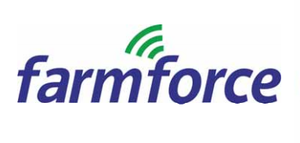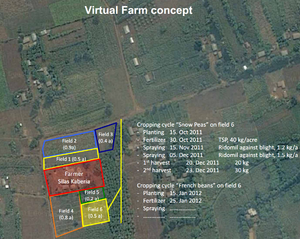

Farmforce is a mobile service that links smallholder farmers to other actors in the agro-value chain. Its strategic value proposition is to reduce transaction costs for contract farming, aid compliance with food standards, improve traceability of goods from the field and agronomy of scale. The service, led by the Syngenta Foundation, has been developed over the last two years and went live in 2013.
Year Launched : 2012
Business Model : Business
Targeted Device : Basic/Feature Phone, PC/Laptop
Primary Delivery Technology : SMS/Apps
Products & Services : Inventory Management, Data Collection
Markets Deployed In : Asia, Africa and Latin America Estimated
Number of Users : Undisclosed
BACKGROUND AND OPPORTUNITY:
What opportunity existed and how was it filled by the organisation? The Syngenta Foundation were interested in linking farmers to higher value markets where distributors and exporters are looking to partner commercially with small holder farmers. A key barrier here was linking farmers with processes involving minimal quantity and quality standards along with traceability requirements to guarantee food safety, fair trade or other sustainability requirements. Even in developing countries, requirements for food quality and food safety are increasing due to urbanisation trends. For example, Vietnam now requires vegetables to have VietGAP standards when supplying to urban centres. This arose as a consequence of scandals involving contaminated vegetables, and can be seen more generally as a function of increasing migration of rural population to large urban areas. Examples like this set the context of a predominant base of small holder farmers supplying an ever growing urban demand. “While this is an opportunity, it increasingly creates a barrier to entry for farmers because of the documentation requirements linked to standards.” In addition, from the buyer’s perspective, it’s much more difficult to buy from five-hundred small holder farmers than one big farm. Farmforce was created to help manage these sorts of problems. First and foremost, Farmforce provides a piece of software that manages information aggregated from small holder farmers. “It’s a tool designed to organise hundreds or thousands of small holder farmers who produce for a particular buyer.” Field officers advising the farmers can access the service, and upload data to the system using their mobile phone. Farmforce provides the management information required to organise their growing activities, but at the same time provides all the documentation, traceability, and compliance with the required standards. The latter is currently conducted on pen and paper, with significant deficits to all actors. “Farmforce is designed to integrate farmers more efficiently into this value chain. The advantage for aggregators is lowered transaction costs. The advantage for small holder farmers is access to new markets.” Farmforce’s software isn’t a tool directly in the hands of farmers, although they can communicate and receive information from the service via SMS. This increases transparency from both the perspective of farmers and aggregators.
PROGRESS SINCE LAUNCH:
How have things gone so far? The service has been under development for the past two years by a team of engineers. “The software development approach taken was an Agile one, meaning that the team selected a few projects in India and Kenya with which to implement and develop Farmforce.” The project was launched in early 2013.
SCALABILITY:
How is the service being scaled to reach a larger audience? Farmforce started with the concept of scale at the outset, i.e., they designed the service with a view to reaching hundreds and thousands of farmers and expanding across multiple markets. This served as a basis for finding the right development tools, software architecture, and other technical requirements. Based on that, Farmforce was designed as a “Software as a Service” approach: The software resides in the Cloud. Users can open private accounts and use it without installation on their own computers. Farmforce recognises that one of the key components of scaling their service to reach a wider customer base is language. The service is currently offered in English and French, but the team has prepared to add new languages on the basis of requests. They anticipate, for example, that Spanish and Portuguese will come very soon. Another key basis for scaling is offering professional support to users. “As Farmforce is a core business software for businesses cooperatives managing outgrower activities, it requires more support to initially set up.” Other issues concerning scale stem from the organisation’s approach to problems, where generic solutions are generally sought out. The issue of regulatory food standards provides a good example. Here it generally isn’t possible to build each and every standard into the system; nor would this make sense, as standards are constantly evolving and changing. “Instead we focus on the question of how standards are built, looking for the common denominators.” Using this approach Farmforce found standards have two different types of information: an assessment component (typically a survey based approach where answers to questions are scored and a minimum score is required to pass); and a documenting component (i.e., recording the farmer’s activity in the field during the growing period). Instead of implementing or replicating standards, Farmforce built functionality into the service to flexibly allow for these two information requirements. Critically, this allows Farmforce to quickly integrate new standards into their system, and enables them to adapt to changing regulatory environments. “While there are a few existing services that incorporate functionality to document processes in line with one or two particular standards, these are limited in applicability. Farmforce aims to overcome this barrier.”
USER CENTRIC ATTITUDES:
How does the organisation build itself around the end user? The Syngenta Foundation takes a hands-on-approach to helping smallholder farmers becoming more productive, getting better access to markets, and helping them manage risks. They do this through a number of projects in Asia, Africa and Latin America. The approach to designing software is informed by the Foundation’s work in the field, and they generally only design products and applications in instances where they are involved on the ground. This ensures that the team understand the use case. In the case of Farmforce, this was developed through a number of pilot projects on the ground in which the Syngenta Foundation was involved. “The team understands that it’s extremely important that the user defines what is required.” In addition, the way the team is integrated, the way requirements are communicated, and the way user requests are dealt with is all oriented around the user. “This is paramount to the organisation as a whole.”
CHALLENGES:
What are the internal and external challenges currently faced? Farmforce was always conceived as a large scale project available to many institutions and projects. This ambition naturally poses a challenge for designing solutions, as these must meet the demands of scale from the beginning. A related challenge arises from the number of add-on-modules required in managing a large outgrowth scheme of many small projects. For example, modules exist for managing various inventory systems, monitoring training activities of farmers, as well as monitoring loans for farmers. The problem here is that the list is seemingly endless, and the team had to find a meaningful scope of modules to include. Internally speaking things have gone smoothly. The organisation dedicated the first three months to defining the software architecture, asking how they wanted to develop the different tools with respect to their goals. They selected the right technology, and based on their requirements hired a virtual team of individuals (sitting between Brazil, China, Panama, and India).
PARTNERSHIPS:
What is the value of partnerships, particularly with MNOs? Farmforce realise that the sector is too complex for one organisation to know everything, and therefore that partnerships are essential. “At the same time it is crucial to have a clear mutual understanding about roles and responsibilities, which may not always be clear enough between existing partners in the development sector.” Farmforce has made particular efforts to define the areas of responsibility when entering partnerships, whether these are with standard setting bodies, or partners on the ground. With respect to Mobile Network Operators, Farmforce can use mobile payment systems such as Safaricom’s mobile payment service. Farmforce also uses the instant payment notifications (IPNs) to automatically update incoming payments. Further, Farmforce can send and receive SMS. Here, delays sending and receiving responses when sending mass SMS is sometimes a challenge, stemming from the quality of premium service providers, which don’t yet meet requirements. Because of this, Farmforce still sends out SMS from a more expensive international gateway.
LOOKING BACK, LOOKING FORWARD:
What key lessons have been learnt, and what are the organisation’s future objectives? “A key requirement for success is to have a clear business model. In the case of IT, a question must be asked about who will eventually pay for the service. This means the service must deliver real value.” From Farmforce’s perspective, they see the aggregators and organizers of outgrower schemes as the key entities to which they add value, and from which they can drive steady revenue. This is a clear future objective. “The other key objective is to gather enough tenants to keep costs at an affordable level for our community of tenants overall.” This will be the focus of the next 2-3 years.
This document was originally produced as part of the former Mobile for Development Impact programme.


